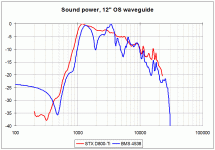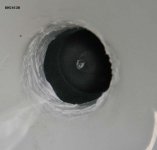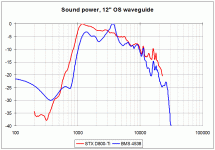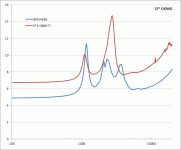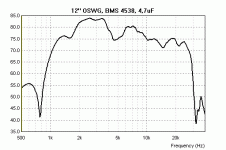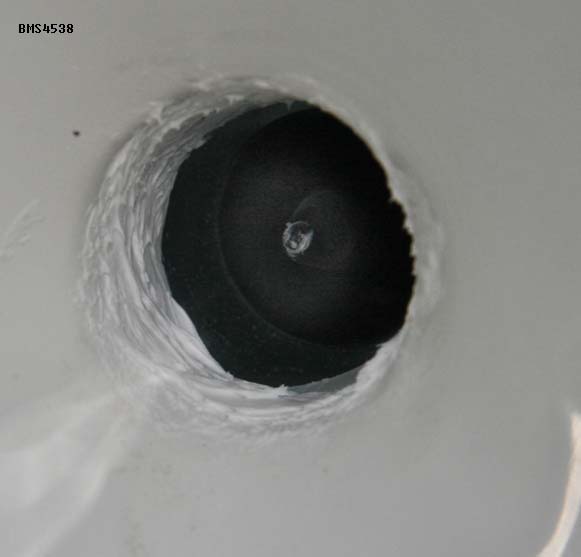If you're willing to throw away some efficiency, the crossover for a compression driver is a lot easier if you include an l-pad in the circuit.
I use L-Pad always. In my case impedance correction works only at amplifier side. Such a correction is questionable for solid state amps - you will just heat the resistor.
Horn resonance is in my case almost +10dBSPL.
Certainly the cost is high relative to a compression driver, but there are some pretty significant advantages- one being that the pattern needn't collapse nearly so much as there's no exponential throat, and there's vertical directivity imposed by the dipole cancellation and the transducer size in that dimension.
Am I right in guessing that the secondary flare of the keele type reduces directivity with decreasing frequency, if only slightly?
I don't follow "one being that the pattern needn't collapse nearly so much as there's no exponential throat" - my patterns don't collapse.
And I also don't understand "guessing that the secondary flare of the keele type reduces directivity with decreasing frequency". In a diffraction device there is first diffraction, followed by a straight section to maintain the directivity down to the lower cutoff due to mouth size, and finally a "radius" or "flare" at the mouth to create a smoother directivity field and to reduce reflections. If this covers your question, then great, if not, than I don't understand.
Send me the data when you are done and I'll include it in my database.
And I also don't understand "guessing that the secondary flare of the keele type reduces directivity with decreasing frequency". In a diffraction device there is first diffraction, followed by a straight section to maintain the directivity down to the lower cutoff due to mouth size, and finally a "radius" or "flare" at the mouth to create a smoother directivity field and to reduce reflections. If this covers your question, then great, if not, than I don't understand.
Of course the secondary flare is to remove the "midrange narrowing" or pattern collapse that typically happens at the lower end of a conical horn's range of pattern control. Empirically Don found that doubling the flare at the mouth gave a reasonable transition. The power series definition for the JBL horns was probably as much a way to get around EV and Altec patents as a necessary shape definition. Certainly the smooth transition helps with mouth reflections and the JBL units were better than the Altec Manta Rays with their hard transitions.
Would you call this a diffraction device? Since the ribbon driver is situated at the start of the horn, there is no transition or diffraction slot, just a throat starting with the ribbon's width.
David
Would you call this a diffraction device? Since the ribbon driver is situated at the start of the horn, there is no transition or diffraction slot, just a throat starting with the ribbon's width.
David
Might be Earl is following my suggestion to look at *all* waveguide / horn as to be simply a "diffraction alignment device".
No - actually that can't be - never ever would *that* happen...
Michael
What do they sell for? Any idea? I want to make sure my prices are comparable
Hi, just read your question.
These are zingalis and are highly recommendend and regarded in germany.
Prices around 3000 $ (Stand) to 18000 $. Don´t know if you heard about the omniray horn principle. This is a zingali own patent - just to clear you up to avoid cases in future regarding global marketing rights.
What I read till now here doesn´t surprise me in fact. A good construction doesn´t "automatically" flow in marketing success but whom I am clearing up ?
I think those in the picture are the higher price range products. I did not see these as the Hi End show this year, don't know whether I accidentally missed them or whether they did not attend. Having looked at the Omni Ray briefing, it seems almost like what I am trying to do, but I haven't seen any polar response measurements.
Would you call this a diffraction device? Since the ribbon driver is situated at the start of the horn, there is no transition or diffraction slot, just a throat starting with the ribbon's width.
David
I was refering to The "Keele" (a diffraction device) comment not the ribbon device.
A ribbon at the throat is not a diffraction device in the same way as a horn wil a slot. The generation of HOM depends on the details of the throat - the wavefront generated by the ribbon must match the wavefront required by the waveguide otherwise there will be HOMs created right at this interface.
I was refering to The "Keele" (a diffraction device) comment not the ribbon device.
A ribbon at the throat is not a diffraction device in the same way as a horn wil a slot. The generation of HOM depends on the details of the throat - the wavefront generated by the ribbon must match the wavefront required by the waveguide otherwise there will be HOMs created right at this interface.
What wavefront would you expect from the AMT? Might we expect a semicylindrical wavefront on either side of the ribbon due to the delay imposed by the "mesh" of steel on the sides of the phragm? Naturally not a pure source but something that might propagate along my straightwalled geometry reasonably well? Or should the attempt be to do it more in the style of the sims shown by Mige0, with a constricted throat attempting a near straight beginning of the profile, then possible going to OS more like yours does with C.D.s?
Prices around 3000 $ (Stand)
EDIT: 3000 $ (bookshelf)! with stands
Some compression drivers have shorting rings. Is it common? I don't think so.
JBL 2426h uses a copper sleeve, and its predecessor the 2425h had a silver (!!) sleeve
Vent holes in horn
Hi,
Just saw something at PLASA trade show(Pro Audio, Lighting etc) I had never seen before. Holes in the side wall of a horn, "to relieve back pressure on the returning wave". If it had been anybody other than Michael O'Neil of One Systems (ex of Electrovoice) I would have passed it off as "sales talk". But I went over to the EV stand, and they also had some new product with holes in similar places. Below is a drawing from EV with holes clearly shown. Any thoughts on the theory behind this? In the one systems product it is not on a coax system.
Iain.
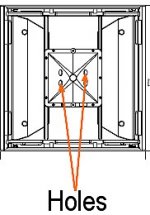
Hi,
Just saw something at PLASA trade show(Pro Audio, Lighting etc) I had never seen before. Holes in the side wall of a horn, "to relieve back pressure on the returning wave". If it had been anybody other than Michael O'Neil of One Systems (ex of Electrovoice) I would have passed it off as "sales talk". But I went over to the EV stand, and they also had some new product with holes in similar places. Below is a drawing from EV with holes clearly shown. Any thoughts on the theory behind this? In the one systems product it is not on a coax system.
Iain.

Hi,
Just saw something at PLASA trade show(Pro Audio, Lighting etc) I had never seen before. Holes in the side wall of a horn, "to relieve back pressure on the returning wave". If it had been anybody other than Michael O'Neil of One Systems (ex of Electrovoice) I would have passed it off as "sales talk". But I went over to the EV stand, and they also had some new product with holes in similar places. Below is a drawing from EV with holes clearly shown. Any thoughts on the theory behind this? In the one systems product it is not on a coax system.
Iain.
View attachment 188397
If my guess is right, Michael O'Neil may have mis-stated himself or may be getting misquoted- sure looks like a unity horn arrangement to me. Those holes are entrances for midrange speakers.
Hi,
Just saw something at PLASA trade show(Pro Audio, Lighting etc) I had never seen before. Holes in the side wall of a horn, "to relieve back pressure on the returning wave". If it had been anybody other than Michael O'Neil of One Systems (ex of Electrovoice) I would have passed it off as "sales talk". But I went over to the EV stand, and they also had some new product with holes in similar places. Below is a drawing from EV with holes clearly shown. Any thoughts on the theory behind this? In the one systems product it is not on a coax system.
Iain.
View attachment 188397
If I'm not mistaken, this is the manual for the loudspeaker in question:
http://www.electrovoice.com/sitefiles/downloads/EVF_and_EVH_User_Manual.pdf
It's in their EVF line, though the "waveguides" with holes is only offered on certain models.
I put quotes around waveguide because this is really a horn. There's also going to be a ton of HOMs generated at the exit, because it's one of the worst terminations I've ever seen.
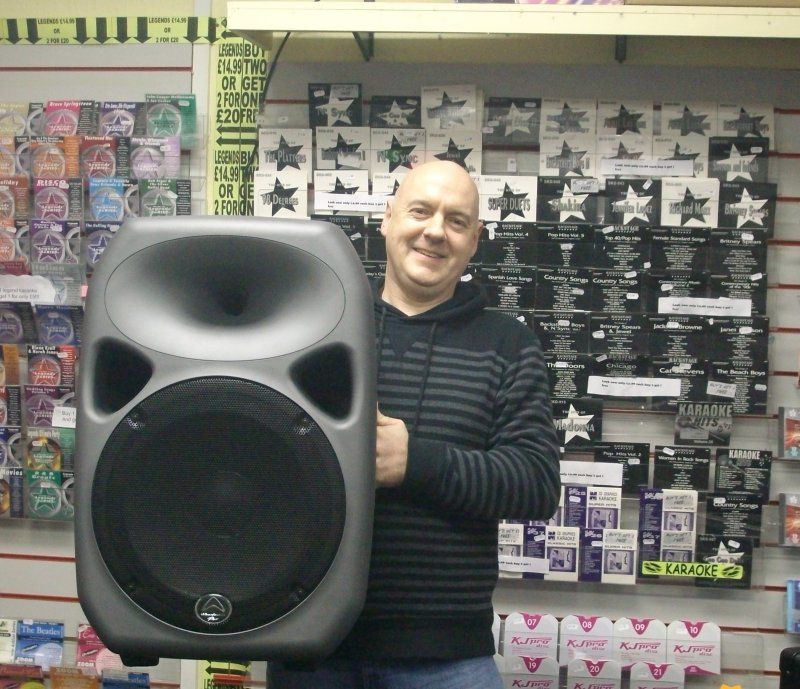
I was in Italy a couple of weeks ago, and heard these in a music store. (This isn't me, or my pic. I found this on the internetz.)
I can't even imagine what it costs to ship a set of Summas to Italy, so these are an intriguing option. They're a set of Wharfedale Titan 15s. You can get them powered or unpowered. It is my belief that a lot of people on this forum spend too much time obsessing about waveguide contours, and not enough time obsessing about the shape of the cabinet, and the quality of the termination at the mouth and the throat of the waveguide. And the quality of the termination on these Wharfedales is VERY good.
I am too embarassed to say how much these cost, and how they sound. Let's just say that they're worth a listen
Last edited:
- Home
- Loudspeakers
- Multi-Way
- Geddes on Waveguides
